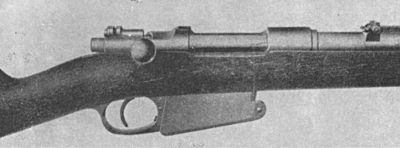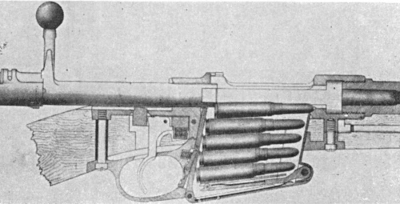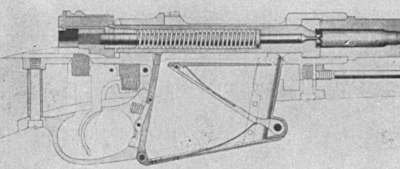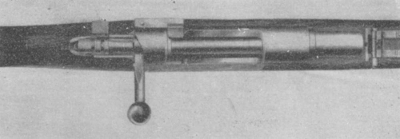The following information on the Model 1890 Turkish Mauser comes from Chapter 16 of Mauser Rifles and Pistols by W. H. B. Smith. Mauser Rifles and Pistols is also available to purchase in print.
In 1890 the Turkish government adopted a modified form of the Belgian Mauser. This rifle for the 7.65mm (or .301-inch) Turkish cartridge was minus the jacket tube of the Belgian model.
This model together with minor modifications of the later 1898 pattern issued in 1903 and 1905 are all in official Turkish use, as are Kar. 98’s and their modifications.

It must be remembered that despite the fact that many countries used “official” rifles, because of the distribution of weapons during World War II equipment of all types may be found in practically all armies in the world today. Thus tremendous numbers of later models of the Mauser rifle using the German cartridge will be found in Turkey. All such rifles, wherever made for Turkey, are slight modifications only of the official German.
However the official 1890 Turkish Mauser rifle has the following characteristics: It weighs 9 pounds 1 ounce without bayonet. The bayonet adds about 1 pound 7 ounces to this weight. The overall length is about 4 feet .5-inch without bayonet. The bayonet adds 1 foot 6 inches. The overall length of the barrel is 29.1 inches, and the barrel is rifled 4-grooves to the right with a twist of one turn in 10 inches.

The sights are standard V and barleycorn with graduations from 250 to 2000 meters and without wind gauge.
The rifle may be loaded with individual cartridges or may be loaded with cartridges stripped in from a clip in standard fashion.
The magazine of the original model followed that of the original Belgian type in that it extended below the bottom of the stock and carried 5-cartridges in a single vertical column, and was detachable.

The original Turkish Mauser varied from the original Belgian in:
1. Cartridge used. While the caliber is the same, the cartridge was somewhat different. This Turkish cartridge measures 2.96 inches overall, is rimless and weighs 370 grains. The bullet is pointed and has a lead core surrounded by a mild steel jacket. The bullet length is 1.06 inch, the maximum diameter .311 inch; weight 154.3 grains.
As originally issued, the cartridge measured 3.07 inch and the bullet 1.2 inch. The powder charge was 47.4 grains of smokeless. More recent loads average about 46 grains of improved powder. The muzzle velocity is about 2001 feet per second while the chamber pressure is about 39,400 pounds per square inch. (Note: Most modern 7.65mm Mauser military calibers will interchange.)
2. Turkish Mausers do not have barrel jackets.
3. The barrel is turned down in steps with the portion between the steps tapering slightly. The sights are attached to the barrel.
The rear sight is shaped with a thin tube below encircling the barrel and is screwed and soldered to the barrel. The face of the leaf is graduated from 400 to 2000 meters in hundred meter steps. At right angles to the leaf at the rear end is a small projection with a notch for 250 meter fire.
4. There is a second opening in the tang just behind the magazine for a point on the front end of the sear which can rise as the trigger is pressed, to engage in a slot in the bolt.
5. The cut-off is a small horizontal one pivoted in the right side of the receiver where it is controlled by a flat spring with a tooth which engages in notches in the cut off.
6. A shallow groove is provided in the bolt for the sear.
7. A flap shaped to lie against the side of the receiver is used instead of the conventional rib type bolt stop.
8. The sear differs somewhat, having a projection at the front end engaging in grooves in the bolt and a special spring.
9. The original Turkish Mauser has the same type of projecting magazine as the Belgian. However, in later designs (1893 and later)a simpler and more compact magazine appears; the magazine body forming part of the prolongation of the trigger guard but not projecting below the bottom of the stock.
The opening for the magazine in the receiver in these later models is somewhat narrower than the magazine itself to permit two columns of 2 and 3 cartridges respectively to be pressed upwards against the overhanging edges. This prevents them from rising out of the magazine except in single turn through the central opening.
The bottom of this magazine is closed by a plate. The magazine spring is of ribbon steel bent into zig-zag form and has its ends secured in an undercut recess in the plate and in the platform (or follower). A rib on the platform at its left side raises the column of cartridges resting upon it, thereby bringing the center of the cartridges in the left column level with the tops of the corresponding cartridges in the opposite column.
When the last cartridge has been fired, as the bolt is pushed forward its face is caught by the rear end of the rib of the magazine follower, preventing it from being closed until the magazine is recharged or the platform is pushed down by the finger. This serves to notify the firer that the weapon is empty.
10. A cut-off is provided on the Turkish rifle permitting the magazine to be held in reserve as in the case of the United States Springfield while the weapon is used as a single loader.
The mechanics and operations are otherwise substantially the same as those already described for the Belgian Model.

Note on Later Turkish Mausers
These differ but slightly from the corresponding German types, notably the Gewehr and Kar. 98 series. Details covering the German types apply to the Turkish Mauser with the exceptions noted.
The official Model 1905 has the following characteristics: Weight is 9 pounds 6 ounces. Length is 4 feet 1 inch (1 foot 8.5 inches more with bayonet attached). Barrel length is 29.1 inches. Caliber 7.65mm Turkish. Right hand twist, one turn in 9.84 inches, 4-grooves. Sights typical V rear adjustable from 400 to 2000 meters and barleycorn front. No wind gauge. Barrel diameter .301 inch. Bullet diameter .311 maximum.
This rifle is equipped with a cut-off permitting holding the magazine in reserve. The magazine is the standard Mauser vertical fixed box, holding 5-cartridges in double staggered rows.

Rifles of Mauser make or pattern to shoot the standard German 7.9mm cartridge are also common in Turkey.
Germany, Belgium, Yugoslavia, Czechoslovakia and even Poland delivered some Mauser-type rifles to Turkey after 1924. These were in either 7.65mm or German 7.92mm calibers. Mechanically these are the same as the German World War II patterns, since all were based on German minor modifications of the original Mauser Gewehr 98.
